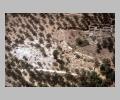
The Menelaion, Sparta.

Prehistoric Menelaion, Sparta.

Vapheio tomb near Sparta, Sparta.

Blocks from marble scene building from the theater on the Spartan Acropoli...

Theater on the Spartan Acropolis, Sparta.
| Summary: | One of the major Classical city-states of ancient Greece. |
| Type: | Unfortified city |
| Region: | Laconia |
Periods:
Dark Age
Geometric
Archaic
Classical
Hellenistic
Roman
Physical:
Located ca. 50 km inland on the wide and fertile plain of the Eurotas valley, Sparta is almost completely surrounded by major mountain ranges. In contrast to other ancient Greek cities, Sparta was not a compact fortified city-state center with monumental civic and religious buildings. It was a loose collection of smaller villages spaced over a large rural area and 6 low hills (cf. Thuc. 1.10.2). The highest of these knolls (ca. 25 m) served as the acropolis and location for the Temple of Athena Chalkioikos. In the Hellenistic period a theater, stoa and agora were built near the acropolis, but the Temple of Athena and the earlier remains at the Sanctuary of Artemis Orthia on the W bank of the Eurotas are almost the only archaeological remains from Archaic and Classical Sparta.
The location and the militaristic character of early Sparta made city walls unnecessary, but as Spartan power weakened construction of fortification walls began (in 307 B.C.). The 10 km long circuit wall was completed in 184 B.C.
Description:
The location of Homeric Sparta is uncertain, and historical Sparta was traditionally a Dorian foundation of the 10th century B.C. By the 7th century B.C. Sparta had conquered all of Laconia and Messenia and by the 6th century all of the central and SW Peloponnese was under direct Spartan control.
In the 5th century B.C. Sparta had control of the Peloponnesian League and in 405 B.C. defeated Athens. The reversal of Spartan power, however, began with their defeat by Thebes in 371 B.C. In 369 B.C. Messenia was liberated and by 195 B.C. Sparta had lost all of its political dependencies.
Under the Romans, Sparta enjoyed a degree of prosperity, in part, because of Roman admiration of the Spartan tradition of discipline. The Romans revived the ancient initiation rites for Spartan youths at the Sanctuary of Artemis, but in a debased touristic manner in which the Spartan youths were flogged in an amphitheater constructed around the altar of Artemis. Sparta survived the Herulian invasions of 267 A.D., but was devastated by the Goths in 395 A.D. and finally abandoned.
Exploration:
Early excavations by C. Waldstein of the American School in 1892-1893. Excavations by the British School in 1906-1910, 1924-1928 and 1949. Beginning in 1957 C. Christou has carried out excavations and rescue operations in the area of the modern city for the Greek Service.
Sources Used:
Other Bibliography:
